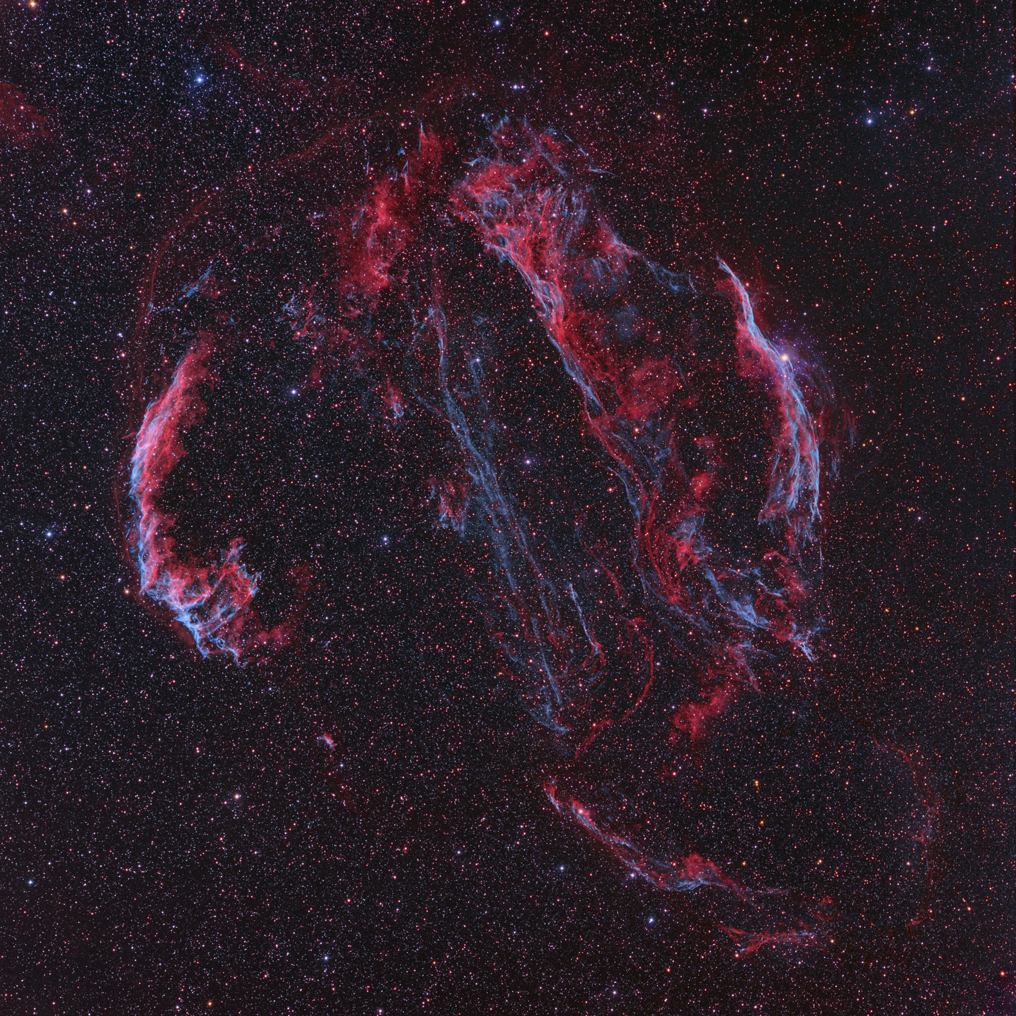The Cygnus Loop
Characteristics:
Size: About 3 degrees; 90 light years
across
Distance: Approximately 1470 light years
RA: 20h 51m 27s (J2000)
Dec: 31 degrees 07' 28" (J2000)
Description:
The famous Cygnus Loop, also known as the Veil Nebula Complex, is shown
above in this 18 hour image consisting of Ha, OIII, and RGB data
collected over 4 nights. The loop is created by an expanding
shockwave resulting from a supernova that exploded approximately
8,000 years ago. The shockwave slams into surrounding dust in the
interstellar medium, ionizing gases such as hydrogen, oxygen, and
sulfur, which emit specific wavelengths of radiation during electron
recapture. Thus, in the above image you can see radiation from
singly ionized
hydrogen (HII, Hydrogen Alpha, 656.3 nm, shown in red) as well as
doubly ionized oxygen (OIII, 496nm and 501nm, shown in teal). The
result is a beautiful, lacelike structure that has fascinated
astronomers since its original discovery in 1784 by William
Herschel. Parts of the Cygnus Loop visible in the above image
include the Eastern Veil
(NGC 6992) on the left, the Western Veil (Witch's Broom) Nebula
(NGC 6960) on the right, and Fleming's
Triangular Wisp (Pickering's Triangle, right of center). The
filamentous structure of the nebula results from the fact that we are
viewing the
thin shockwave fronts edge-on.
A supernova results from a massive star (at least 8 solar masses) that
has used up most of its elements through fusion, converting hydrogen to
helium, oxygen, silicon, sulfur, calcium, gold, and eventually
iron. Iron is not a viable fuel for fusion (it requires too much
energy), meaning that this element represents the end of the line for a
dying star. Without the outward force of fusion-induced
radiation, the star collapses under its own gravity, resulting in a
massive explosion and release of radiation, some of which we see as
visible light. Based upon the current rate of expansion of the
Cygnus Loop, and accounting for the expected slowing of this expansion
rate over time as the shockwave interacts with the interstellar medium,
the supernova explosion that created this nebula is estimated to
have occurred around 8,000 years ago, just before the beginning of
recorded human history. Those humans gazing upwards at the time
must have seen the sudden appearance of a very bright "star" that waned
in intensity over several weeks to months. The
stellar remnant of a supernova explosion is a neutron star or a black
hole (depending upon the size of the residual star). If the
residual star is between
1.44 and 3 solar masses, it forms a neutron star.
If it is
greater than 3 solar masses, it forms a black hole.
Whether a neutron star or a black hole, the remnant
of the supernova explosion that created the Cygnus Loop has not yet
been identified. The bright star overlying the Western Veil (left
hand
side of the image) is 52 Cygni, a foreground star that is not related
to
the nebula.
Controversy existed for many years regarding the distance to this
nebula,
which was originally thought to be in the range of 2,500 light
years. More
recent data using the Far Ultraviolet Spectroscopic Explorer (FUSE)
has identified a star (KPD2055+311) that emits strongly in UV light,
located behind the Cygnus
Loop at a distance of 1860 light years.
Thus, 1860 light years represents an upper limit to the distance of the
Cygnus Loop. This supports data from Blair
et al using the Hubble Telescope, which placed the Cygnus Loop at a
distance of 1470 light years, now accepted as the most
reliable estimate. Additional information about this
interesting region may be found here.
Photographic
Details:
Dates of image acquistion: July 18, August 19, 20, and 21, 2020
Scope:
Takahashi
FSQ106 at f5 on the Takahashi NJP
Mount
Autoguider: SBIG ST-402
with
60mm guidescope, focal length 227mm
Camera:
Apogee U16M at -20C, with
7 position 50mm square filter wheel (Apogee FW50-7S)
Filters: Baader
Ha, Baader RGB filters
Exposures: Total
exposure 18 hours
Post-processing:
Calibrated, aligned and
stacked in Maxim, followed
by DDP
in ImagesPlus (IP). Further
processing in Photoshop CS (16
bit format)
Please
note: Graphics on this website
may not be reproduced without author permission.
Back to Latest
Images
Back to Nebulae
Home



